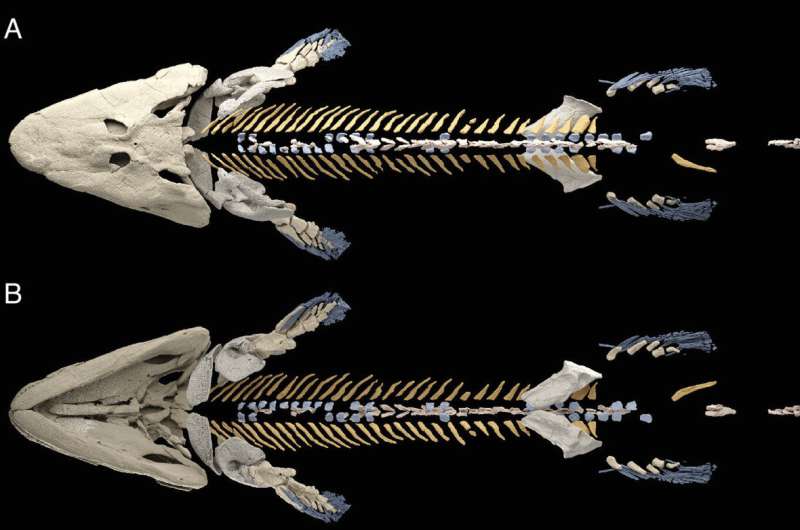This article has been reviewed according to Science X's editorial process and policies. Editors have highlighted the following attributes while ensuring the content's credibility:
fact-checked
peer-reviewed publication
trusted source
proofread
New data from fossil shows changes in axial skeleton that foreshadow the evolution of walking

Before the evolution of legs from fins, the axial skeleton—including the bones of the head, neck, back and ribs—was already going through changes that would eventually help our ancestors support their bodies to walk on land.
A research team including a Penn State biologist completed a new reconstruction of the skeleton of Tiktaalik, the 375-million-year-old fossil fish that is one of the closest relatives to limbed vertebrates. The new reconstruction shows that the fish's ribs likely attached to its pelvis, an innovation thought to be crucial to supporting the body and for the eventual evolution of walking.
A paper describing the new reconstruction, which used microcomputed tomography (micro-CT) to scan the fossil and reveal vertebrae and ribs of the fish that were previously hidden beneath rock, was published April 2 in the Proceedings of the National Academy of Sciences.
"Tiktaalik was discovered in 2004, but key parts of its skeleton were unknown," said Tom Stewart, assistant professor of biology in the Eberly College of Science at Penn State and one of the leaders of the research team. "These new high-resolution micro-CT scans show us the vertebrae and ribs of Tiktaalik and allow us to make a full reconstruction of its skeleton, which is vital to understanding how it moved through the world."
Unlike most fish, which have vertebrae and ribs that are the same along the length of the trunk, the axial skeletons of limbed vertebrates show dramatic differences in the vertebrae and ribs from the head region to the tail region. The evolution of this regionalization allowed the performance of specialized functions, one of which was a mechanical linkage between ribs in the sacral region to the pelvis that enabled support of the body by the hind limbs.
The pelvic fins of fish are evolutionarily related to hind limbs in tetrapods—four-limbed vertebrates, including humans. In fish, the pelvic fins and bones of the pelvic girdle are relatively small and float freely in the body. For the evolution of walking, the researchers explained, the hind limbs and pelvis became much larger and formed a connection to the vertebral column as a way of bracing the forces related to supporting the body.
"Tiktaalik is remarkable because it gives us glimpses into this major evolutionary transition," Stewart said. "Across its whole skeleton, we see a combination of traits that are typical of fish and life in water as well as traits that are seen in land-dwelling animals."
The original description of Tiktaalik focused on the front portion of the skeleton. Fossils were meticulously prepared to remove the surrounding matrix of rock and expose the skull, shoulder girdle and pectoral fins. The ribs in this area were large and expanded, suggesting that they may have supported the body in some way, but it was unclear exactly how they would have functioned. In 2014, the fish's pelvis, discovered in the same location as the rest of the skeleton, was also cleaned of matrix and described.
"From past studies, we knew that the pelvis was large, and we had a sense that the hind fins were large too, but until now couldn't say if or how the pelvis interacted with the axial skeleton," Stewart said. "This reconstruction shows, for the first-time, how it all fit together and gives us clues about how walking might have first evolved."
The researchers explained that, unlike our own hips where our bones fit tightly together, the connection between the pelvis and axial skeleton of Tiktaalik was likely a soft-tissue connection made of ligaments.
"Tiktaalik had specialized ribs that would have connected to the pelvis by a ligament," Stewart said. "It's astonishing really. This creature has so many traits—large pair of hind appendages, large pelvis, and connection between the pelvis and axial skeleton—that were key to the origin of walking. And while Tiktaalik probably wasn't walking across land, it was definitely doing something new. This was a fish that could likely prop itself up and push with its hind fin."
The new reconstruction of the skeleton also sheds light on specializations for head mobility in Tiktaalik and new details of the fish's pelvic fin anatomy.
"It's incredible to see the skeleton of Tiktaalik captured in such vivid detail," said Neil Shubin, Robert R. Bensley Distinguished Service Professor of Organismal Biology and Anatomy at the University of Chicago and one of the authors of the paper. "This study sets the stage for ones that explore how the animal moved about and interacted with its environment 375 million years ago."
More information: Thomas A. Stewart et al, The axial skeleton of Tiktaalik roseae, Proceedings of the National Academy of Sciences (2024). DOI: 10.1073/pnas.2316106121
Journal information: Proceedings of the National Academy of Sciences
Provided by Pennsylvania State University




















